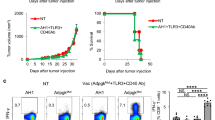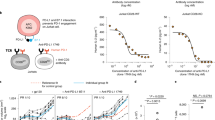Abstract
A promising strategy in tumor immunotherapy is the use of activated dendritic cells as vehicles for tumor vaccines with the goal of activating anti-tumor T cell responses. Current formulations for dendritic cell-based immunotherapies have limited effects on patient survival, providing motivation for further investigation of ways to enhance dendritic cell priming of anti-tumor T cell responses. Using a brief in vitro priming model, we have found that B7-H1 expressed by activated dendritic cells is integrated during priming of naïve CD8+ T cells and functions to limit the differentiation of effector T cell responses. CD8+ T cells primed by B7-H1-deficient dendritic cells exhibit increased production of IFN-γ, enhanced target cell killing, and improved anti-tumor activity. Additionally, enhanced memory populations arise from CD8+ T cells primed by B7-H1-deficient dendritic cells. Based on these findings, we suggest that early blockade of B7-H1 signaling should be investigated as a strategy to improve dendritic cell-based anti-tumor immunotherapy.






Similar content being viewed by others
Abbreviations
- B6:
-
C57BL6
- BM:
-
Bone marrow
- CTL:
-
Cytotoxic T lymphocyte
- KO:
-
Knock out
- MFI:
-
Mean fluorescence intensity
- WT:
-
Wild type
References
Masopust D, Kaech SM, Wherry EJ, Ahmed R (2004) The role of programming in memory T-cell development. Curr Opin Immunol 16:217–225. doi:10.1016/j.coi.2004.02.005
Lanzavecchia A, Sallusto F (2002) Progressive differentiation and selection of the fittest in the immune response. Nat Rev Immunol 2:982–987. doi:10.1038/nri959
Iezzi G, Karjalainen K, Lanzavecchia A (1998) The duration of antigenic stimulation determines the fate of naive and effector T cells. Immunity 8:89–95
Mescher MF, Curtsinger JM, Agarwal P et al (2006) Signals required for programming effector and memory development by CD8+ T cells. Immunol Rev 211:81–92. doi:10.1111/j.0105-2896.2006.00382.x
Chen L (2004) Co-inhibitory molecules of the B7–CD28 family in the control of T-cell immunity. Nat Rev Immunol 4:336–347. doi:10.1038/nri1349
Slavik JM, Hutchcroft JE, Bierer BE (1999) CD28/CTLA-4 and CD80/CD86 families: signaling and function. Immunol Res 19:1–24. doi:10.1007/BF02786473
Lanzavecchia A, Sallusto F (2000) From synapses to immunological memory: the role of sustained T cell stimulation. Curr Opin Immunol 12:92–98
Viola A, Schroeder S, Sakakibara Y, Lanzavecchia A (1999) T lymphocyte costimulation mediated by reorganization of membrane microdomains. Science 283:680–682
Dong H, Zhu G, Tamada K, Chen L (1999) B7-H1, a third member of the B7 family, co-stimulates T-cell proliferation and interleukin-10 secretion. Nat Med 5:1365–1369. doi:10.1038/70932
Freeman GJ, Long AJ, Iwai Y et al (2000) Engagement of the PD-1 immunoinhibitory receptor by a novel B7 family member leads to negative regulation of lymphocyte activation. J Exp Med 192:1027–1034
Dong H, Strome SE, Salomao DR et al (2002) Tumor-associated B7-H1 promotes T-cell apoptosis: a potential mechanism of immune evasion. Nat Med 8:793–800. doi:10.1038/nm730
Butte MJ, Keir ME, Phamduy TB et al (2007) Programmed death-1 ligand 1 interacts specifically with the B7-1 costimulatory molecule to inhibit T cell responses. Immunity 27:111–122. doi:10.1016/j.immuni.2007.05.016
Keir ME, Butte MJ, Freeman GJ, Sharpe AH (2008) PD-1 and its ligands in tolerance and immunity. Annu Rev Immunol 26:677–704. doi:10.1146/annurev.immunol.26.021607.090331
Pulko V, Liu X, Krco CJ et al (2009) TLR3-stimulated dendritic cells up-regulate B7-H1 expression and influence the magnitude of CD8 T cell responses to tumor vaccination. J Immunol 183:3634–3641. doi:10.4049/jimmunol.0900974
Wherry EJ (2011) T cell exhaustion. Nat Immunol 12:492–499. doi:10.1038/ni.2035
Kantoff PW, Higano CS, Shore ND et al (2010) Sipuleucel-T immunotherapy for castration-resistant prostate cancer. N Engl J Med 363:411–422. doi:10.1056/NEJMoa1001294
van Stipdonk MJ, Lemmens EE, Schoenberger SP (2001) Naïve CTLs require a single brief period of antigenic stimulation for clonal expansion and differentiation. Nat Immunol 2:423–429. doi:10.1038/87730
van Stipdonk MJB, Hardenberg G, Bijker MS et al (2003) Dynamic programming of CD8+ T lymphocyte responses. Nat Immunol 4:361–365. doi:10.1038/ni912
Arens R, Schoenberger SP (2010) Plasticity in programming of effector and memory CD8 T-cell formation. Immunol Rev 235:190–205. doi:10.1111/j.0105-2896.2010.00899.x
Ehst BD, Ingulli E, Jenkins MK (2003) Development of a novel transgenic mouse for the study of interactions between CD4 and CD8 T cells during graft rejection. Am J Transplant 3:1355–1362. doi:10.1046/j.1600-6135.2003.00246.x
Brown JA, Dorfman DM, Ma F-R et al (2003) Blockade of programmed death-1 ligands on dendritic cells enhances T cell activation and cytokine production. J Immunol 170:1257–1266
Selenko-Gebauer N, Majdic O, Szekeres A et al (2003) B7-H1 (programmed death-1 ligand) on dendritic cells is involved in the induction and maintenance of T cell anergy. J Immunol 170:3637–3644
Gröschel S, Piggott KD, Vaglio A et al (2008) TLR-mediated induction of negative regulatory ligands on dendritic cells. J Mol Med 86:443–455. doi:10.1007/s00109-008-0310-x
Goldberg MV, Maris CH, Hipkiss EL et al (2007) Role of PD-1 and its ligand, B7-H1, in early fate decisions of CD8 T cells. Blood 110:186–192. doi:10.1182/blood-2006-12-062422
Benedict CA, Loewendorf A, Garcia Z et al (2008) Dendritic cell programming by cytomegalovirus stunts naive T cell responses via the PD-L1/PD-1 pathway. J Immunol 180:4836–4847
Gibbons RM, Liu X, Pulko V et al (2012) B7-H1 limits the entry of effector CD8+ T cells to the memory pool by upregulating Bim. Oncoimmunology 1(7):1061–1073. doi:10.4161/onci.20850
Acknowledgments
We are thankful to Tian Tian (Harvard University) for providing OT-1 Thy 1.1+ mice, Lieping Chen (Yale University) for providing B7-H1 KO mice, G4 hybridoma cells, and 10B5 hybridoma cells, Dr. Koji Tamada for anti-B7-H1 (43H12) monoclonal antibody, and Richard Vile (Mayo Clinic) for providing B16-OVA tumor cells. This work was supported by the American Cancer Society’s New Investigator Award, the Wendy Case Cancer Research Fund, and in part by the National Institutes of Health (RO1 CA134345).
Conflict of interest
Eugene. D. Kwon, Haidong Dong, and Mayo Clinic have a financial conflict of interest related to this research (Patents of B7-H1 as a cancer prognostic marker). This research has been reviewed by the Mayo Clinic Conflict of Interest Review Board and is being conducted in compliance with Mayo Clinic conflict of interest policies. The other authors have no financial conflicts of interest.
Author information
Authors and Affiliations
Corresponding author
Additional information
Drs. Eugene D. Kwon and Haidong Dong share senior authorship.
Electronic supplementary material
Below is the link to the electronic supplementary material.
Rights and permissions
About this article
Cite this article
Gibbons, R.M., Liu, X., Harrington, S.M. et al. B7-H1 signaling is integrated during CD8+ T cell priming and restrains effector differentiation. Cancer Immunol Immunother 63, 859–867 (2014). https://doi.org/10.1007/s00262-014-1563-6
Received:
Accepted:
Published:
Issue Date:
DOI: https://doi.org/10.1007/s00262-014-1563-6




